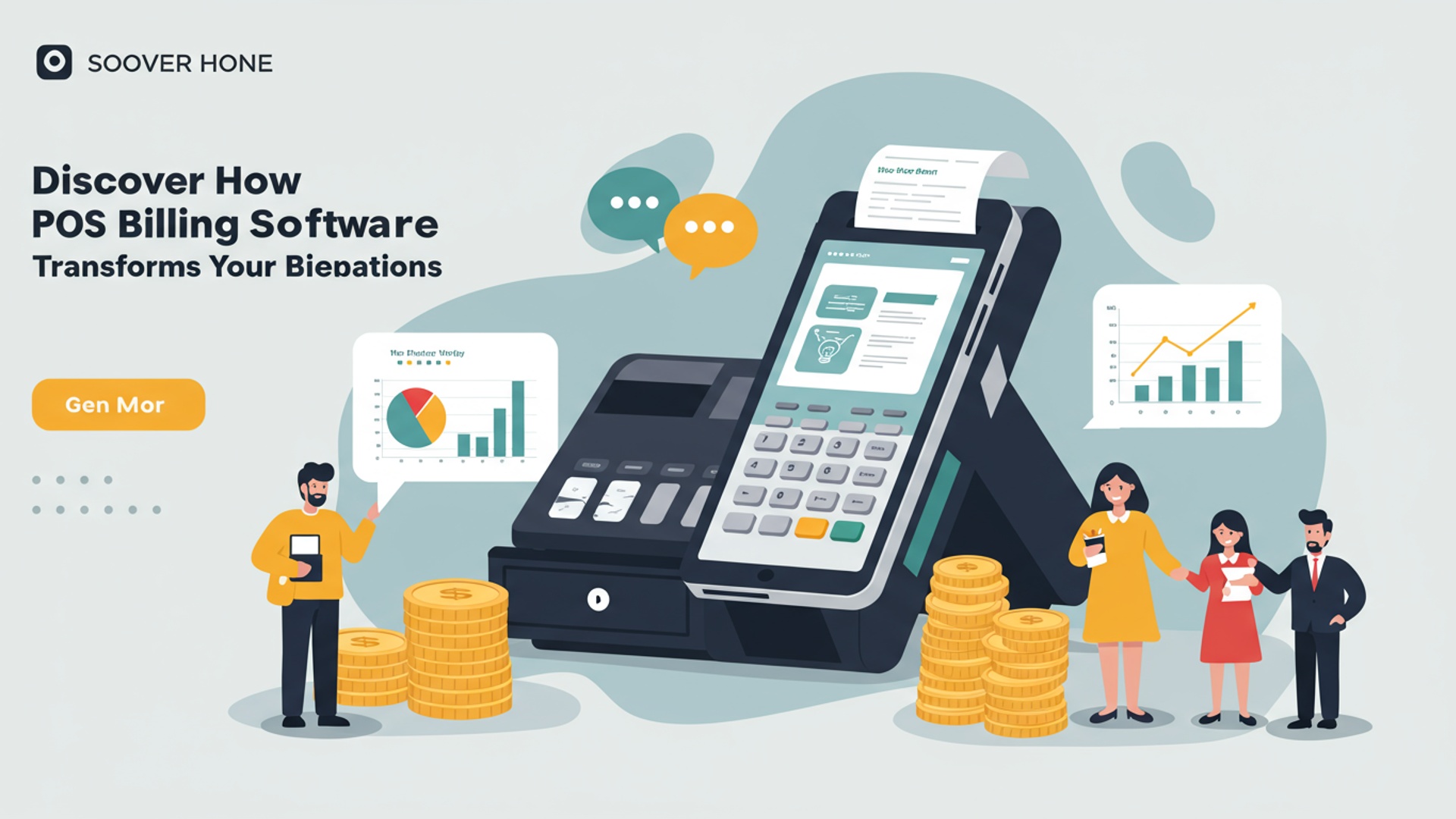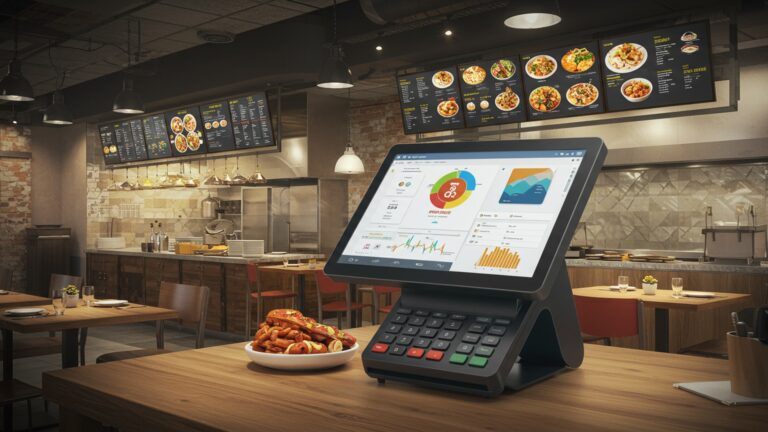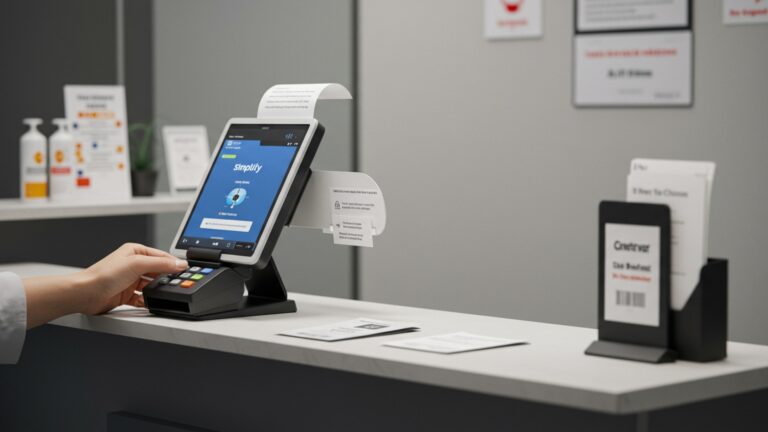Discover How POS Billing Software Transforms Your Business Operations
Businesses today navigate an increasingly complex landscape, where customer expectations demand instant, personalized service and flawless transactions, often overwhelming outdated systems. Manual processes frequently create bottlenecks, leading to inaccurate inventory, slow checkouts. missed revenue opportunities. This is precisely where advanced pos billing software emerges as an indispensable operational backbone, transforming more than just sales. Modern iterations, leveraging cloud integration and AI-driven analytics, instantly turn raw transactional data into actionable insights for inventory optimization, dynamic pricing. hyper-personalized customer engagement. Recent developments emphasize seamless omnichannel experiences, allowing retailers to unify in-store, online. mobile sales channels. This strategic shift empowers businesses to move beyond reactive sales, fostering proactive decision-making and significantly enhancing operational efficiency and profitability in a competitive market.

Understanding POS Billing Software: More Than Just a Cash Register
In today’s fast-paced retail and hospitality landscape, the term ‘Point of Sale’ (POS) has evolved far beyond the traditional cash register. At its core, POS refers to the place where a customer makes a payment for goods or services. But, modern pos billing software is a sophisticated system that integrates various business functions, making it an indispensable tool for operational efficiency and growth. Think of it as the central nervous system of your business, handling transactions, managing inventory, tracking sales. much more.
Historically, a cash register simply recorded sales and calculated change. The advent of computers brought rudimentary electronic cash registers. the leap to comprehensive pos billing software marked a paradigm shift. Today’s systems are robust platforms designed to streamline operations, enhance customer experience. provide invaluable business intelligence.
Core Functionalities of Modern POS Billing Software:
- Transaction Processing
- Inventory Management
- Customer Relationship Management (CRM)
- Employee Management
- Reporting and Analytics
- Payment Processing
The primary function, enabling quick and accurate sales, returns. exchanges.
Tracks stock levels in real-time, automates reordering. monitors product movement.
Stores customer data, purchase history. facilitates loyalty programs.
Manages employee shifts, tracks sales performance. handles timekeeping.
Generates detailed reports on sales, inventory, customer trends. more.
Integrates with various payment gateways, supporting credit/debit cards, mobile payments. contactless options.
A typical pos billing software setup involves both hardware and software components. The hardware might include a touch-screen monitor or tablet, a barcode scanner, a receipt printer. a cash drawer. The software is the intelligence behind it, processing data, managing operations. presenting insights.
Streamlining Operations: The Core of POS Transformation
The true power of modern pos billing software lies in its ability to centralize and automate many previously manual or disparate tasks. This operational streamlining leads directly to increased efficiency, reduced errors. significant cost savings. Consider a bustling cafe, for instance. Without robust POS, managing orders, payments. inventory could quickly become chaotic.
Faster Transactions and Reduced Wait Times:
One of the most immediate benefits businesses experience is the acceleration of the checkout process. Barcode scanning, integrated payment processing. intuitive user interfaces allow staff to process sales much quicker than manual entry. This directly translates to shorter queues and a more pleasant experience for customers, especially during peak hours. A study by the National Retail Federation consistently highlights speed and convenience as top priorities for shoppers, making efficient transaction processing a competitive advantage.
Automated Inventory Management:
Manual inventory counts are time-consuming, prone to errors. often lead to stockouts or overstocking. POS billing software automates this critical function. Every sale automatically deducts items from inventory, providing real-time stock levels. When inventory drops below a predefined threshold, the system can even trigger automated purchase orders to suppliers. This not only saves labor but also optimizes capital tied up in inventory, reducing waste and ensuring popular items are always available. For example, a small boutique using Lightspeed POS reported a 15% reduction in dead stock within six months of implementation due to better inventory insights.
Employee Management and Performance Tracking:
Many pos billing software solutions include features for employee management. This can range from tracking clock-in/out times to monitoring individual sales performance. Managers can easily see which employees are top performers, identify training needs. optimize staffing schedules based on historical sales data. This data-driven approach fosters accountability and helps improve overall team productivity.
Enhanced Sales Reporting and Analytics:
Gone are the days of sifting through paper records to comprehend sales trends. Modern pos billing software generates comprehensive reports on demand. Businesses can examine sales by product, category, time of day, employee. more. This granular data is crucial for identifying best-selling products, understanding peak sales periods. making informed decisions about pricing and promotions.
Integration with Other Business Systems:
A truly transformative pos billing software doesn’t operate in a silo. It integrates seamlessly with other essential business applications such as accounting software (e. g. , QuickBooks, Xero), CRM systems. e-commerce platforms. This ensures data consistency across the organization, eliminates duplicate data entry. provides a holistic view of business performance. For instance, when a sale is made via your Square POS, the transaction details automatically sync with your accounting software, simplifying reconciliation at month-end.
Boosting Customer Experience and Loyalty
In today’s competitive market, customer experience is often the primary differentiator. POS billing software plays a pivotal role in creating seamless, personalized. rewarding interactions that foster lasting customer loyalty.
Personalized Service Through Customer Data:
When integrated with a CRM module, pos billing software allows businesses to capture and store valuable customer insights, including purchase history, preferences. contact details. This data empowers staff to offer personalized recommendations, remember past purchases. even address customers by name. Imagine a coffee shop where the barista instantly knows your usual order because it’s linked to your loyalty account – that’s the power of data-driven personalization.
Loyalty Programs and Rewards Management:
Implementing effective loyalty programs becomes effortless with advanced pos billing software. Businesses can easily set up points-based systems, tiered rewards, or special discounts for loyal customers. The software automates the tracking of points, redemption of rewards. communication of personalized offers, incentivizing repeat business. A prime example is Starbucks, whose reward program, deeply integrated with their POS, drives significant customer retention and engagement.
Efficient Returns and Exchanges:
Dealing with returns and exchanges can often be a point of friction for both customers and staff. POS billing software simplifies this process by quickly locating original transactions, verifying purchase details. processing refunds or exchanges with minimal hassle. This efficiency transforms a potentially negative experience into a positive one, reinforcing customer trust.
Multiple Payment Options:
In a world of diverse payment preferences, offering flexibility is key. Modern pos billing software supports a wide array of payment methods, from traditional cash and credit/debit cards to mobile payment solutions like Apple Pay and Google Pay. even emerging options like cryptocurrency in some advanced systems. This convenience ensures customers can pay But they prefer, reducing cart abandonment and improving overall satisfaction.
Data-Driven Decisions: Unlocking Business Intelligence
Perhaps one of the most transformative aspects of pos billing software is its ability to convert raw transaction data into actionable business intelligence. This insight allows business owners to move beyond guesswork and make strategic decisions based on concrete evidence.
Sales Trends and Forecasting:
By analyzing historical sales data, businesses can identify seasonal trends, peak sales periods. the impact of promotions. This insights is invaluable for forecasting future sales, optimizing staffing levels. planning marketing campaigns. For instance, a clothing retailer might notice a consistent surge in sweater sales during late fall, enabling them to stock up adequately before the season hits.
Product Performance Analysis:
Which products are your best sellers? Which ones are collecting dust on the shelves? POS billing software provides detailed reports on product performance, allowing you to identify popular items, grasp profit margins per product. make informed decisions about merchandising and inventory. This helps in optimizing product assortments and discontinuing underperforming items, thus freeing up capital and shelf space.
Identifying Peak Hours and Staffing Needs:
Detailed sales data by hour and day helps businesses grasp their busiest periods. This insight is critical for optimizing staff scheduling, ensuring adequate coverage during peak times. avoiding overstaffing during slower periods. This not only improves customer service but also significantly reduces labor costs.
Reducing Shrinkage and Loss Prevention:
Comprehensive pos billing software helps track every transaction and inventory movement, making it easier to identify discrepancies that could indicate theft, spoilage, or administrative errors. By integrating with security cameras and implementing strict user permissions, businesses can significantly reduce shrinkage and improve overall accountability. A restaurant owner once shared how their new TouchBistro POS helped them identify a pattern of “voided” transactions that didn’t match inventory, leading to the discovery of internal theft – a situation almost impossible to track manually.
Example of a simple sales report data structure:
{ "date": "2023-10-26", "total_sales": 1520. 75, "transactions_count": 85, "top_products": [ {"item_id": "P001", "name": "Espresso Machine", "quantity_sold": 10, "revenue": 500. 00}, {"item_id": "P005", "name": "Organic Coffee Beans", "quantity_sold": 30, "revenue": 300. 00} ], "payment_methods": { "credit_card": 900. 25, "cash": 400. 50, "mobile_pay": 220. 00 }
}
Security and Compliance: Protecting Your Business and Customers
In an age where data breaches are unfortunately common, the security features of pos billing software are paramount. Protecting sensitive customer details and ensuring compliance with industry standards is not just good practice, it’s a legal and ethical imperative.
PCI DSS Compliance:
The Payment Card Industry Data Security Standard (PCI DSS) is a set of security standards designed to ensure that all companies that process, store, or transmit credit card details maintain a secure environment. Reputable pos billing software providers ensure their systems are PCI DSS compliant, meaning they adhere to strict guidelines for handling cardholder data, thereby minimizing the risk of data breaches and protecting both the business and its customers from financial fraud.
Data Encryption:
Advanced pos billing software employs robust encryption protocols to secure sensitive data, both in transit (when data is being sent from the POS terminal to the payment processor) and at rest (when data is stored on servers). This scrambling of data makes it unreadable to unauthorized parties, adding a critical layer of protection against cyber threats.
User Access Controls:
To prevent internal fraud and unauthorized access, modern pos billing software features granular user access controls. This allows business owners to define different levels of access for various employees, ensuring that only authorized personnel can perform specific actions, such as processing refunds, accessing sensitive reports, or modifying inventory data. For example, a cashier might only have access to the sales interface, while a manager would have full access to reporting and administrative functions.
Fraud Prevention:
Beyond PCI compliance and encryption, many pos billing software solutions incorporate features designed to detect and prevent fraudulent transactions. This can include real-time fraud monitoring, address verification services (AVS). CVV (Card Verification Value) checks. These measures significantly reduce the risk of chargebacks and financial losses for the business.
Choosing the Right POS Billing Software for Your Business
Selecting the ideal pos billing software is a critical decision that can significantly impact your business’s efficiency, customer satisfaction. profitability. It’s not a one-size-fits-all solution. careful consideration of several factors is essential.
Factors to Consider:
- Industry Specificity
- Business Scale and Growth
- Budget
- Features
- Ease of Use
Does the software cater to your specific industry (retail, restaurant, salon, etc.) ? Industry-specific features can make a huge difference.
Is the software scalable to grow with your business? Can it handle multiple locations, increased transaction volumes, or new product lines?
Consider both upfront costs (hardware, setup) and ongoing costs (subscriptions, transaction fees, support).
Evaluate the core functionalities against your business needs – inventory, CRM, reporting, employee management, etc.
An intuitive interface reduces training time and increases employee adoption.
On-Premise vs. Cloud-Based Solutions:
This is a fundamental choice when selecting pos billing software. Each has distinct advantages and disadvantages:
| Feature | On-Premise POS | Cloud-Based POS |
|---|---|---|
| Data Storage | Servers located physically at your business. | Data stored on remote servers (cloud). |
| Accessibility | Limited to your business network. | Accessible from anywhere with internet connection. |
| Cost | Higher upfront cost (hardware, installation); lower recurring fees. | Lower upfront cost (subscription model); higher recurring fees. |
| Maintenance | Requires in-house IT expertise or third-party support. | Managed by the vendor; automatic updates. |
| Security | Your responsibility to manage and secure. | Vendor responsible for security and backups. |
| Scalability | Can be complex and costly to scale. | Easily scalable, often with tiered subscriptions. |
For many small to medium-sized businesses, cloud-based pos billing software offers greater flexibility, lower initial investment. automatic updates, making it a popular choice. But, businesses with specific security or customization needs might prefer on-premise solutions.
Scalability and Integration Capabilities:
As your business evolves, your POS needs will too. Ensure the chosen pos billing software can scale to accommodate future growth, such as adding new locations, increasing product lines, or expanding into e-commerce. Moreover, verify its integration capabilities with other essential tools you use or plan to use, like your accounting software, email marketing platform, or online store. Seamless integration prevents data silos and enhances overall operational fluidity.
Vendor Support and Training:
Even the most robust pos billing software can encounter issues. Excellent customer support from the vendor is crucial. Look for providers that offer 24/7 support, comprehensive training resources (videos, guides). a dedicated account manager if your business warrants it. Initial setup and ongoing training for your staff are also vital to maximize the software’s potential and ensure a smooth transition.
By carefully evaluating these factors and aligning them with your unique business requirements, you can select a pos billing software that not only addresses your current needs but also serves as a powerful engine for future growth and transformation.
Conclusion
The journey to truly transform your business operations culminates in embracing advanced POS billing software, moving far beyond mere transaction processing. It’s about leveraging real-time data to make smarter decisions, much like how many local eateries now use sales analytics to perfectly time their ingredient orders, reducing waste and boosting freshness. This strategic shift is a current trend, with businesses recognizing that a modern POS isn’t just a cash register. a powerful engine for growth and efficiency. My personal tip for any business owner is to thoroughly audit your existing operational bottlenecks; you’ll likely find that a robust POS system offers an integrated solution for many of them, from inventory woes to complex loyalty programs. For instance, imagine effortlessly managing customer data for targeted promotions, a capability I’ve seen dramatically increase repeat business for small boutiques. Don’t just look for a system that works; seek one that excels at integrating all your operational touchpoints, from online orders to in-store sales, reflecting recent developments in omnichannel retail. Ultimately, investing in the right POS software isn’t an expense. a foundational investment in your business’s future resilience and competitive edge. Take the leap, discover the unparalleled clarity it brings to your operations. watch your business thrive with newfound efficiency and strategic foresight.
More Articles
Unlock Efficiency How to Choose Top POS Billing Software for Your Business
Learn How to Choose the Right POS Software for Efficient Retail Operations
How to Master Inventory Management POS India 10 Strategies for Success
How to Easily Set Up and Use Mobile POS Software for Seamless Sales
Mastering Restaurant POS Software A Comprehensive Guide for Efficient Management
FAQs
What exactly is POS billing software and how can it help my business?
POS (Point of Sale) billing software is a system that handles your sales transactions, processes payments. often much more. It helps streamline your checkout process, making it faster and more accurate, which is a huge step up from manual methods or basic cash registers.
How does this software improve day-to-day operations?
It transforms operations by automating key tasks. Think faster checkouts, instant sales reporting, easier returns. less paperwork. This frees up your staff to focus on customers instead of getting bogged down in administrative tasks.
Can POS software really help manage inventory better?
Absolutely! Many POS systems come with robust inventory management features. They track stock levels in real-time with every sale, help you identify popular products. even alert you when it’s time to reorder. This prevents stockouts and reduces overstocking.
Is it only for retail stores, or can other businesses use it too?
While commonly associated with retail, POS software is incredibly versatile. Restaurants, salons, cafes, service businesses. even small businesses operating online or at pop-up events can all benefit from its features for managing sales, appointments. customer data.
What are the benefits beyond just processing sales?
Beyond sales, it offers powerful insights through reporting, helping you comprehend sales trends, peak hours. staff performance. It can also manage customer loyalty programs, gift cards. even integrate with accounting software, giving you a holistic view of your business.
Will it make my customer service experience better?
Definitely. Faster transactions mean shorter lines. Access to customer purchase history helps staff offer personalized recommendations or handle returns smoothly. Loyalty programs built into the system also keep customers coming back, enhancing their overall experience.
Is it complicated to set up and use?
Modern POS software is designed to be user-friendly. Most systems have intuitive interfaces that require minimal training. While initial setup involves some data entry, many providers offer support to get you up and running quickly, making the transition much smoother than you might expect.






